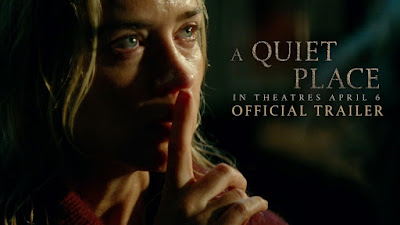Film Analysis - 'A Quiet Place' (Directed by John Krasinski)
Official Trailer: https://www.youtube.com/watch?v=WR7cc5t7tv8.
Sites for reference:
-Wikipedia: https://en.wikipedia.org/wiki/A_Quiet_Place_(film).
-IMDB: https://www.imdb.com/title/tt6644200/.
'A Quiet Place' is a 2018 horror, science-fiction, thriller (with a running time of 90 minutes) that was directed by John Krasinski (https://en.wikipedia.org/wiki/John_Krasinski) and produced by Michael Bay, Brad Fuller and Andrew Form. The film itself grossed over $338.6 million within the box office, greatly exceeding its original budget of (a relatively small,) $17 million; though proving to be a success within the film industry, it did face a number of rather unique issues within cinemas globally as the plots focus heavy on silence (as suggested by the name) lead to problems with sound produced by the audience during public screenings, such as people talking and consumption of food items within the theatre during scenes of (building) tension.
The film focuses on a family living within rural america during a recent apocalyptic event of seemingly unknown origin that forces those who survived to live in a state of relatively constant silence; this premise is used greatly to the advantage of the film as the generation of tension is mainly done through the usage of audio deprivation (and sudden reintroduction). Communication between characters is done using sign language (with subtitles so the audience can understand), through the additional rare moments of audible communication and general bodily interaction, we are given an in depth look into the psyche of the small cast of characters as they continue to try and function as a loving family within this unique, intense survival situation.
The film itself is based on an american farm mainly consisting of vast corn fields which serve as a source of tension, creating slight diegetic audio as well as imposing a sense of claustrophobia upon the film's cast and audience. This large location greatly serves to the benefit of the film however as it introduces a lack of control to the plot, maintaining a constant state of silence within such a sizeable area would be impossible for most and therefor suggests that conflict is an inevitability for the protagonists. Through out the film there are frequent time based transitions, introducing the great cinematographic element of the dark. During the scenes based at night, tension rises and creates this overwhelming atmosphere of danger as the audience is further deprived of their initial senses; though it could be argued that constantly 'taking away' from the audience will ultimately remove the necessary cinematographic foundations of the film, it mainly works to the film's favour by further engaging the audience and leaving them in a constant state of sensory absorption, often discouraging the average viewer from disturbing the atmosphere that is cast upon them by the film's relatively distinct arsenal of visual and audio based mechanics.
Sites for reference:
-Wikipedia: https://en.wikipedia.org/wiki/A_Quiet_Place_(film).
-IMDB: https://www.imdb.com/title/tt6644200/.
The film focuses on a family living within rural america during a recent apocalyptic event of seemingly unknown origin that forces those who survived to live in a state of relatively constant silence; this premise is used greatly to the advantage of the film as the generation of tension is mainly done through the usage of audio deprivation (and sudden reintroduction). Communication between characters is done using sign language (with subtitles so the audience can understand), through the additional rare moments of audible communication and general bodily interaction, we are given an in depth look into the psyche of the small cast of characters as they continue to try and function as a loving family within this unique, intense survival situation.
The film itself is based on an american farm mainly consisting of vast corn fields which serve as a source of tension, creating slight diegetic audio as well as imposing a sense of claustrophobia upon the film's cast and audience. This large location greatly serves to the benefit of the film however as it introduces a lack of control to the plot, maintaining a constant state of silence within such a sizeable area would be impossible for most and therefor suggests that conflict is an inevitability for the protagonists. Through out the film there are frequent time based transitions, introducing the great cinematographic element of the dark. During the scenes based at night, tension rises and creates this overwhelming atmosphere of danger as the audience is further deprived of their initial senses; though it could be argued that constantly 'taking away' from the audience will ultimately remove the necessary cinematographic foundations of the film, it mainly works to the film's favour by further engaging the audience and leaving them in a constant state of sensory absorption, often discouraging the average viewer from disturbing the atmosphere that is cast upon them by the film's relatively distinct arsenal of visual and audio based mechanics.





Comments
Post a Comment